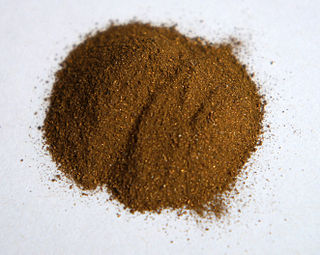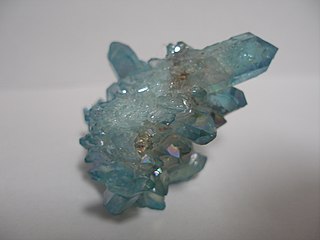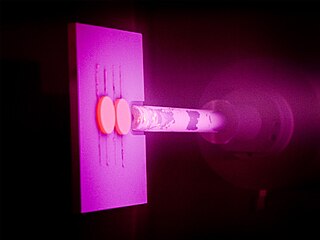This article needs additional citations for verification .(February 2010) |



A rhinestone, paste or diamante is a diamond simulant originally made from rock crystal but since the 19th century from crystal glass or polymers such as acrylic.
This article needs additional citations for verification .(February 2010) |



A rhinestone, paste or diamante is a diamond simulant originally made from rock crystal but since the 19th century from crystal glass or polymers such as acrylic.
Originally, rhinestones were rock crystals gathered from the river Rhine, hence the name, although some were also found in areas like the Alps (the source of the Rhine). Today the name "rhinestone" applies only to varieties of lead glass known as crystal glass. The availability of such products increased greatly in the 18th century when the Alsatian jeweller Georg Friedrich Strass (1701–1773) developed imitation diamonds by coating the lower side of lead glass with metal powder. Many European languages use the word strass (or equivalent) to refer to rhinestones.
As opposed to the classic rhinestones, which had a metal-powder coating on the bottom side only, several companies have opted to mass-produce iridescent lead glass by reducing the metal-coating thickness and applying it uniformly, not using metal powder with a binder but applying various forms of metal deposition (thin foil, vapor deposition, etc.). Such developments include Favrile glass by Tiffany in 1894, Carnival glass under the name "Iridrill" by Fenton in 1908, "Aurora Borealis" glass by Swarovski in 1956 and PVD-coated dichroic glass in the late 20th century, amongst many other decorative lead glasses coated with a thin metal layer and sold under various commercial names such as "rainbow glass," "aurora glass" and such.
Rhinestones can be used as imitations of diamonds, and some manufacturers even manage to partially reproduce the glistening effect which real diamonds have in the sun.
Typically, crystal rhinestones have been used on costumes, apparel, and jewelry. Crystal rhinestones are produced mainly in Austria by Swarovski and in the Czech Republic by Preciosa and a few other glassworks in northern Bohemia. In the United States, these are sometimes known as "Austrian crystal."
The rhinestone-studded Nudie suit was invented by Nudie Cohn in the 1940s, an Americanization of the matador's "suit of lights." Rhinestone material is often used as an alternative to sequins.
A popular type of rhinestone is the AB (Aurora borealis) rhinestone. AB rhinestones have a particular type of iridescent coating, applied with vacuum metal deposition. [2]
Guy de Maupassant's short story "La Parure" from 1884 centers around a seemingly valuable diamond necklace which turns out, to the protagonist's chagrin, to have been made of paste.
Liberal use of rhinestones was associated with country music singers, as well as with singer Elvis Presley and pianist Liberace. In 1974 David Allan Coe released the album The Mysterious Rhinestone Cowboy and referred to himself as The Rhinestone Cowboy again in the 1977 song "Longhaired Redneck." In 1975 Glen Campbell had a top hit with the song "Rhinestone Cowboy" and became known as the "Rhinestone Cowboy." That song served as the basis for the 1984 movie Rhinestone starring Sylvester Stallone and Dolly Parton. The British virtual band Gorillaz released the single "Rhinestone Eyes" in 2010. The closing track on Madvillain's Madvillainy is titled "Rhinestone Cowboy." Carrie Underwood's ninth album, released in 2022, is titled "Denim & Rhinestones."
Rhinestones are sized by using the term "ss," or stone size, following a number to indicate size (e.g. 8ss is equivalent to 2.3 mm diameter, 10ss is 2.8 mm). [3] Many of the commonly used rhinestone sizes are slightly smaller than currency. [4] SS is more commonly used for apparel means, while PP (or pearl plate) is used for jewelry. [5]
Hot-fix rhinestones, also known as heat-transfer rhinestones, are mainly used for apparel. The flat bottom of the stone has a glue backing and, when heated, melts onto the surface of the clothing. These can be adhered using a regular clothes iron, although it is recommended to use a heat press. A heat press is able to reach higher temperatures (standard transfers require temperatures of up to 180–200 °C (350–400 °F)) while applying heavy pressures resulting in a more professional quality. [6]

A bead is a small, decorative object that is formed in a variety of shapes and sizes of a material such as stone, bone, shell, glass, plastic, wood, or pearl and with a small hole for threading or stringing. Beads range in size from under 1 millimeter (0.039 in) to over 1 centimeter (0.39 in) in diameter.

Chemical vapor deposition (CVD) is a vacuum deposition method used to produce high-quality, and high-performance, solid materials. The process is often used in the semiconductor industry to produce thin films.

Ruby is a pinkish red to blood-red colored gemstone, a variety of the mineral corundum. Ruby is one of the most popular traditional jewelry gems and is very durable. Other varieties of gem-quality corundum are called sapphires. Ruby is one of the traditional cardinal gems, alongside amethyst, sapphire, emerald, and diamond. The word ruby comes from ruber, Latin for red. The color of a ruby is due to the element chromium.

Cubic zirconia (abbreviated CZ) is the cubic crystalline form of zirconium dioxide (ZrO2). The synthesized material is hard and usually colorless, but may be made in a variety of different colors. It should not be confused with zircon, which is a zirconium silicate (ZrSiO4). It is sometimes erroneously called cubic zirconium.

Industrial processes are procedures involving chemical, physical, electrical, or mechanical steps to aid in the manufacturing of an item or items, usually carried out on a very large scale. Industrial processes are the key components of heavy industry.
Plating is a finishing process in which a metal is deposited on a surface. Plating has been done for hundreds of years; it is also critical for modern technology. Plating is used to decorate objects, for corrosion inhibition, to improve solderability, to harden, to improve wearability, to reduce friction, to improve paint adhesion, to alter conductivity, to improve IR reflectivity, for radiation shielding, and for other purposes. Jewelry typically uses plating to give a silver or gold finish.

Metallizing is the general name for the technique of coating metal on the surface of objects. Metallic coatings may be decorative, protective or functional.
Swarovski is an Austrian producer of glass based in Wattens in the Tyrol. It was founded in 1895 by Daniel Swarovski.

A diamond simulant, diamond imitation or imitation diamond is an object or material with gemological characteristics similar to those of a diamond. Simulants are distinct from synthetic diamonds, which are actual diamonds exhibiting the same material properties as natural diamonds. Enhanced diamonds are also excluded from this definition. A diamond simulant may be artificial, natural, or in some cases a combination thereof. While their material properties depart markedly from those of diamond, simulants have certain desired characteristics—such as dispersion and hardness—which lend themselves to imitation. Trained gemologists with appropriate equipment are able to distinguish natural and synthetic diamonds from all diamond simulants, primarily by visual inspection.

Titanium nitride is an extremely hard ceramic material, often used as a physical vapor deposition (PVD) coating on titanium alloys, steel, carbide, and aluminium components to improve the substrate's surface properties.

Powder coating is a type of coating that is applied as a free-flowing, dry powder. Unlike conventional liquid paint, which is delivered via an evaporating solvent, powder coating is typically applied electrostatically and then cured under heat or with ultraviolet light. The powder may be a thermoplastic or a thermosetting polymer. It is usually used to create a thick, tough finish that is more durable than conventional paint. Powder coating is mainly used for coating of metal objects, particularly those subject to rough use. Advancements in powder coating technology like UV-curable powder coatings allow for other materials such as plastics, composites, carbon fiber, and medium-density fibreboard (MDF) to be powder coated, as little heat or oven dwell time is required to process them.

Dichroic glass is glass which can display multiple different colors depending on lighting conditions.

Metal-coated crystals are artificial products made by coating crystals, such as quartz, with metal to give them an iridescent metallic sheen. Crystals treated this way are used as gemstones and for other decorative purposes. Possible coatings include gold, indium, titanium, niobium and copper. Other names for crystals treated in this way include aqua aura, angel aura, flame aura, opal aura or rainbow quartz.
Micromy is a hard surface coating company based in Täby, Sweden. The company specializes in applying hard coating to a wide range of substrate materials using a PVD process. Depending on the application, different coating film materials can be produced, such as TiN, TiC, TiNC, AlTiN or DLC. The coating is mainly used for industrial applications based on the different properties of the materials. However, the PVD process results in a finish such that many coatings are equally suitable for decorative purposes.

Physical vapor deposition (PVD), sometimes called physical vapor transport (PVT), describes a variety of vacuum deposition methods which can be used to produce thin films and coatings on substrates including metals, ceramics, glass, and polymers. PVD is characterized by a process in which the material transitions from a condensed phase to a vapor phase and then back to a thin film condensed phase. The most common PVD processes are sputtering and evaporation. PVD is used in the manufacturing of items which require thin films for optical, mechanical, electrical, acoustic or chemical functions. Examples include semiconductor devices such as thin-film solar cells, microelectromechanical devices such as thin film bulk acoustic resonator, aluminized PET film for food packaging and balloons, and titanium nitride coated cutting tools for metalworking. Besides PVD tools for fabrication, special smaller tools used mainly for scientific purposes have been developed.

Thermal spraying techniques are coating processes in which melted materials are sprayed onto a surface. The "feedstock" is heated by electrical or chemical means.

A diamond tool is a cutting tool with diamond grains fixed on the functional parts of the tool via a bonding material or another method. As diamond is a superhard material, diamond tools have many advantages as compared with tools made with common abrasives such as corundum and silicon carbide.

Transfer paper is used in textiles and arts and crafts projects. Transfer paper is a thin piece of paper coated with wax and pigment. Often, an ink-jet or other printer is used to print the image on the transfer paper. A heat press can transfer the image onto clothing, canvas, or other surface. Transfer paper is used in creating iron-ons. Transfer papers can also be used for the application of rhinestones to clothing and other arts and crafts projects.
Georg Friedrich Strass was a jeweler and inventor of imitation gemstones from Alsace. He is best known as the inventor of the rhinestone, called strass in many European languages, from a particular type of crystal he found in the river Rhine.
Industrial porcelain enamel is the use of porcelain enamel for industrial, rather than artistic, applications. Porcelain enamel, a thin layer of ceramic or glass applied to a substrate of metal, is used to protect surfaces from chemical attack and physical damage, modify the structural characteristics of the substrate, and improve the appearance of the product.
![]() Media related to Rhinestone at Wikimedia Commons
Media related to Rhinestone at Wikimedia Commons